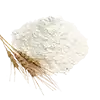Cook the Book: Goat Cheese Danishes

You can never have too many hor d'oeuvre recipes, so give Cook the Book: Goat Cheese Danishes If you have active yeast, cake flour, sugar, and a few other ingredients on hand, you can make it. From preparation to the plate, this recipe takes around 4 hours.
Instructions
1
Put the cake flour in a big bowl, then drop in the cool butter cubes—that is, right out of the fridge, just now cut into little pieces. Use a fork or a pastry cutter to push the fat through the flour, continually working it all around the bowl, cleaning the tines often, then going at it again. There’s way more fat here than flour, way more butter than you’d use for a pie crust, so the resulting mixture will be about the consistency of the stuff in a jar of elementary-school paste that’s been left uncovered overnight.You can also do this task in a food processor fitted with the choppingblade.
Ingredients you will need![All Purpose Flour]() All Purpose Flour
All Purpose Flour![Pie Crust]() Pie Crust
Pie Crust![Butter]() Butter
Butter
Equipment you will use![Food Processor]() Food Processor
Food Processor![Pastry Cutter]() Pastry Cutter
Pastry Cutter![Bowl]() Bowl
Bowl
2
Add the flour and butter, and process until the mass starts toadhere into a ball.
Ingredients you will need![Butter]() Butter
Butter![All Purpose Flour]() All Purpose Flour
All Purpose Flour
3
Line a clean, dry work surface with wax paper. Gather the dough together, then turn it out onto the wax paper. Set another sheet of wax paper on top.
Ingredients you will need![Dough]() Dough
Dough
Equipment you will use![Wax Paper]() Wax Paper
Wax Paper
4
Roll the dough into a 9 x 12-inch (23 x 30.5-cm) rectangle. Note the missing words "about" or "approximately." Don’t cheat; use a ruler and make the rectangle exactly the right size by repositioning the rolling pin repeatedly and rolling just once or twice in each direction before changing and rolling in another set of directions. Once you’ve got the rectangle, pick it up still between its sheets of wax paper, set it on a large baking sheet, and put the whole thing in the fridge for at least 1 hour or up to 24 hours.
Ingredients you will need![Dough]() Dough
Dough![Roll]() Roll
Roll
Equipment you will use![Baking Sheet]() Baking Sheet
Baking Sheet![Rolling Pin]() Rolling Pin
Rolling Pin![Wax Paper]() Wax Paper
Wax Paper
5
Heat the milk in a large saucepan over low heat until the milk is between 100°F and 105°F (38°C and 41°C). It’s important to be accurate. Use an instant-read meat thermometer to be sure, taking the milk’s temperature without letting the probe touch the pan itself.
Ingredients you will need![Meat]() Meat
Meat![Milk]() Milk
Milk
Equipment you will use![Kitchen Thermometer]() Kitchen Thermometer
Kitchen Thermometer![Sauce Pan]() Sauce Pan
Sauce Pan![Frying Pan]() Frying Pan
Frying Pan
6
Once the milk is at the right temperature, take it off the heat and stir in 3 tablespoons sugar and the yeast. Set the pan aside for 5 minutes to proof the yeast—that is, to make sure it’s bubbly, even foamy, starting to come alive and producing the fizzy carbon dioxide that will eventually make the pastry rise.
Ingredients you will need![Sugar]() Sugar
Sugar![Yeast]() Yeast
Yeast![Milk]() Milk
Milk
Equipment you will use![Frying Pan]() Frying Pan
Frying Pan
7
Dump in the 2 cups (330 g) all-purpose flour and 2 tablespoons of the beaten egg (reserve the rest of the beaten egg in the fridge for later in the recipe). Stir a bit; then once the stuff starts to form a dough, turn it out onto a clean, dry, lightly flour-dusted work surface and knead for 2 minutes, pulling it with one hand while twisting the stretched lump and at the same time digging the palm of your other hand into it. Basically, you want to create a smooth dough, not as silky as good bread dough, but still coherent and cohesive. Cover it with a clean kitchen towel and let it rest on the counter for 10 minutes.
Ingredients you will need![All Purpose Flour]() All Purpose Flour
All Purpose Flour![Dough]() Dough
Dough![Egg]() Egg
Egg
Equipment you will use![Kitchen Towels]() Kitchen Towels
Kitchen Towels
8
Clean up your work surface so it’s got no sticky bits of dough, dry it well, then dust it lightly with flour. Set the lump of dough in the center and use a rolling pin to roll it into a 14 x 20-inch (35.5 x 50-cm) rectangle.
Ingredients you will need![Dough]() Dough
Dough![All Purpose Flour]() All Purpose Flour
All Purpose Flour![Roll]() Roll
Roll
Equipment you will use![Rolling Pin]() Rolling Pin
Rolling Pin
9
Take the chilled butter dough out of the fridge and set it on top of and at one end of the flour dough so that the 12-inch (30.5-cm) side of the buttery rectangle is an inch (2.5 cm) or so from but also parallel to the 14-inch (35.5-cm) side of the larger sheet of dough. Turn the dough so that the buttery rectangle is farthest from you. Now fold the larger dough sheet up and over the buttery one, thereby encasing it. Work around the dough to seal all the edges.
Ingredients you will need![Dough]() Dough
Dough![Butter]() Butter
Butter![All Purpose Flour]() All Purpose Flour
All Purpose Flour
10
Roll it out again into a large rectangle, about 14 x 20 inches (35.5 x 50 cm)—not exactly this time, just close enough. If you knead it during this step, you can dust your work surface with a little flour, but do so as infrequently as possible, using as little as possible. More flour = more gluten = the possibility of a tougher dough.
Ingredients you will need![Dough]() Dough
Dough![All Purpose Flour]() All Purpose Flour
All Purpose Flour![Roll]() Roll
Roll
11
Take one short side of this rectangle and fold it over until it comes to the two-thirds mark on the rectangle’s long side. Now take the other exposed side and fold it over the other way, thus folding the piece of dough into three equal sections on top of each other.
Ingredients you will need![Dough]() Dough
Dough
12
Roll this piece of dough out into a large rectangle, about 14 x 20 inches (36 x 51 cm). Then do this three more times: folding it into thirds and rolling it back out, and then again, and then again. Fold the dough into thirds one last time, then set it in the refrigerator to chill for 1 hour.
Ingredients you will need![Dough]() Dough
Dough![Roll]() Roll
Roll
1
Mix the fresh chèvre or soft goat cheese, the large whole egg (not the reserved beaten egg), the sugar, all-purpose flour, and nutmeg in a bowl until creamy and smooth. Take out that remainder of the beaten egg from the fridge and whisk it with 1 tablespoons water.
Ingredients you will need![All Purpose Flour]() All Purpose Flour
All Purpose Flour![Goat Cheese]() Goat Cheese
Goat Cheese![Egg]() Egg
Egg![Nutmeg]() Nutmeg
Nutmeg![Sugar]() Sugar
Sugar![Water]() Water
Water
Equipment you will use![Whisk]() Whisk
Whisk![Bowl]() Bowl
Bowl
2
To make the danishes, take the chilled dough out of the refrigerator and slice it into 3 equal pieces. Clean and dry that work surface yet again. (Is it any wonder why pastry chefs are so irritable?) Give it a light dusting with flour. On that surface, roll each piece of the dough out to a 6 x 8-inch (15 x 20-cm) rectangle, about inch (.6 cm) thick. Be fairly precise but not obsessive—because once all 3 are rolled out, you will trim them to perfect 5 x 7 -inch (13 x 19-cm) rectangles with perfectly straight edges. (The excess dough can be thrown out or baked on its own for little puff pastry twists or braids.)
Ingredients you will need![Puff Pastry Sheets]() Puff Pastry Sheets
Puff Pastry Sheets![Dough]() Dough
Dough![All Purpose Flour]() All Purpose Flour
All Purpose Flour![Roll]() Roll
Roll
3
Cut each of these rectangles into six 2 x 2 -inch (6 x 6-cm) squares. In other words, make one straight cut parallel to the 7 -inch (19-cm) sides, and two even cuts parallel to the 5-inch (13-cm) sides.
4
Place a heaping tablespoon of the filling in each square. Fold the cornersof each square toward the center to meet in the middle over the filling. Dab a little of the beaten-egg-and-water mixture on the dough to seal it at the center point. Once all the little packets are made, line a large baking sheet with a silicone mat or parchment paper, and put the filled packets on a large baking sheet, cover them with a clean kitchen towel, and let them rest at room temperature for 30 minutes. Meanwhile, position the rack in the center of the oven and preheat the oven to 400°F (205°C).
Ingredients you will need![Dough]() Dough
Dough![Water]() Water
Water![Egg]() Egg
Egg
Equipment you will use![Baking Paper]() Baking Paper
Baking Paper![Kitchen Towels]() Kitchen Towels
Kitchen Towels![Baking Sheet]() Baking Sheet
Baking Sheet![Oven]() Oven
Oven
5
Bake until the danishes are puffed and golden brown, about 20 minutes. Cool for a minute or two on the baking sheet, then transfer to a wire rack and continue cooling. Once they’re at room temperature (if they make it that long), they can be stored on the counter in a zip-sealed plastic bag for a couple of days or in the freezer for several months.
Equipment you will use![Baking Sheet]() Baking Sheet
Baking Sheet![Ziploc Bags]() Ziploc Bags
Ziploc Bags![Wire Rack]() Wire Rack
Wire Rack![Oven]() Oven
Oven
Equipment
Ingredients
2teaspoons![active dry yeast]() active dry yeast70grams
active dry yeast70grams![1/2 cup cake flour]() 1/2 cup cake flour1large
1/2 cup cake flour1large![egg, at room temperature]() egg, at room temperature2teaspoons
egg, at room temperature2teaspoons![all-purpose flour]() all-purpose flour250grams
all-purpose flour250grams![ounces fresh chèvre or soft goat cheese, at room temperature]() ounces fresh chèvre or soft goat cheese, at room temperature180milliliters
ounces fresh chèvre or soft goat cheese, at room temperature180milliliters![3/4 cup plus 1 tablespoon (15 ml) regular goat milk (do not use low-fat)]() 3/4 cup plus 1 tablespoon (15 ml) regular goat milk (do not use low-fat)1teaspoons
3/4 cup plus 1 tablespoon (15 ml) regular goat milk (do not use low-fat)1teaspoons![freshly grated nutmeg]() freshly grated nutmeg1Tbsp
freshly grated nutmeg1Tbsp![sugar]() sugar
sugar
 active dry yeast70grams
active dry yeast70grams 1/2 cup cake flour1large
1/2 cup cake flour1large egg, at room temperature2teaspoons
egg, at room temperature2teaspoons all-purpose flour250grams
all-purpose flour250grams ounces fresh chèvre or soft goat cheese, at room temperature180milliliters
ounces fresh chèvre or soft goat cheese, at room temperature180milliliters 3/4 cup plus 1 tablespoon (15 ml) regular goat milk (do not use low-fat)1teaspoons
3/4 cup plus 1 tablespoon (15 ml) regular goat milk (do not use low-fat)1teaspoons freshly grated nutmeg1Tbsp
freshly grated nutmeg1Tbsp sugar
sugarDifficultyExpert
Ready In4 hrs
Servings18
Health Score3
Related recipes
Salmon Linguine Alfredo
Indonesian Chicken Skewers with Peanut Sauce (Satay Ayam)
Crab-Brie Cheese Ball
Spice-Rubbed Turkey
Magazine

Your Inner Chef with Taylor Swift's Top 3 Recipes from Her Beloved NYC Hangout

20 Mouthwatering Recipes You Need to Try Today!

Master the Art of Making Perfect Pancakes with This Foolproof Recipe

The Science Behind Red Wine: Its Surprising Health Benefits and Potential Risks

12 Wine Cocktails for a Sophisticated Twist

Sip, Swirl, and Celebrate: Toasting to National Wine Day on May 25th

National Drink Wine Day on February 18

Celebrating Souffle Day with Delectable Delights

Indulge in the Delightful Flavor of Oyster Soup on Its Special Day!

Celebrating World Nutella Day

Different Types of Fish and Their Unique Characteristics

Fish and Meat Consumption in Modern Diets

Exploring the World of Meat Delicious Recipes

10 Irresistible Beef Recipes That Will Make Your Taste Buds Dance

Easy and Refreshing August Recipes

September Recipes to Try at Home

Rich Food Culture of the Middle East

The Roadmap to Self-Taught Cooking Excellence

Discover the 5 Essential Basics for Every Home Chef

A Quick and Easy Guide to Cooking Fast Food at Home

Your Inner Chef with Taylor Swift's Top 3 Recipes from Her Beloved NYC Hangout

Celebrate National Pizza Day on February 9th with Mouthwatering Slices and Fun Facts

Indiana's Exciting Addition to the Summer Food Program for School Children

Readers' Top Picks for the Best Restaurant Desserts on National Dessert Day

Artichoke Tomato Pesto Flatbread Recipe A Scrumptious Twist on Savory Classics

Mastering Weeknight Meals with 30 Days of 25-Minute Dinner Recipes

Healthy and Delicious 5-Ingredient Breakfast Recipes

Top 10 Pioneer Woman Recipes of 2023!

From Ropa Vieja to Mojitos Traditional Cuban Cuisine















